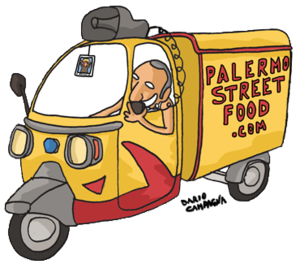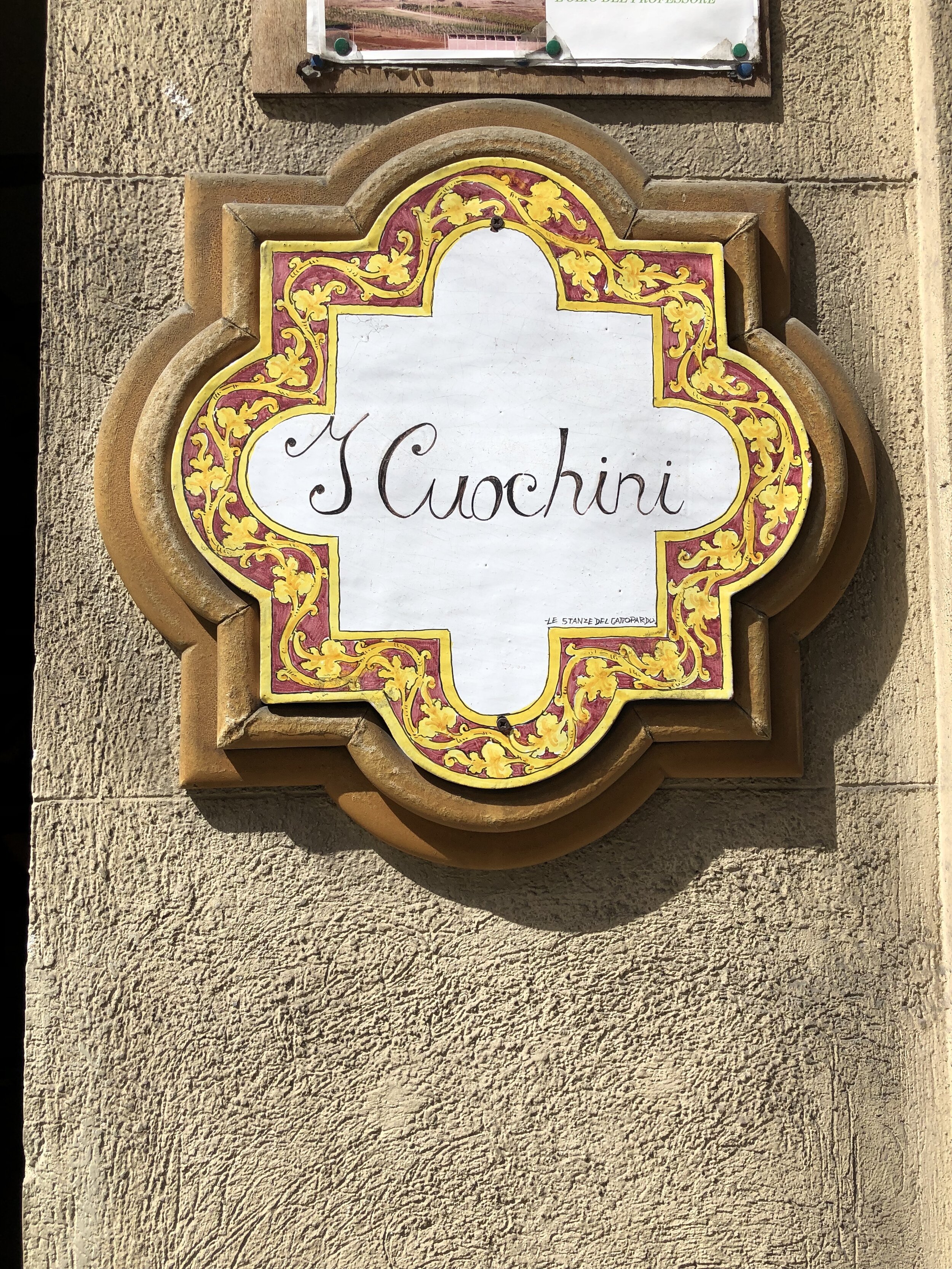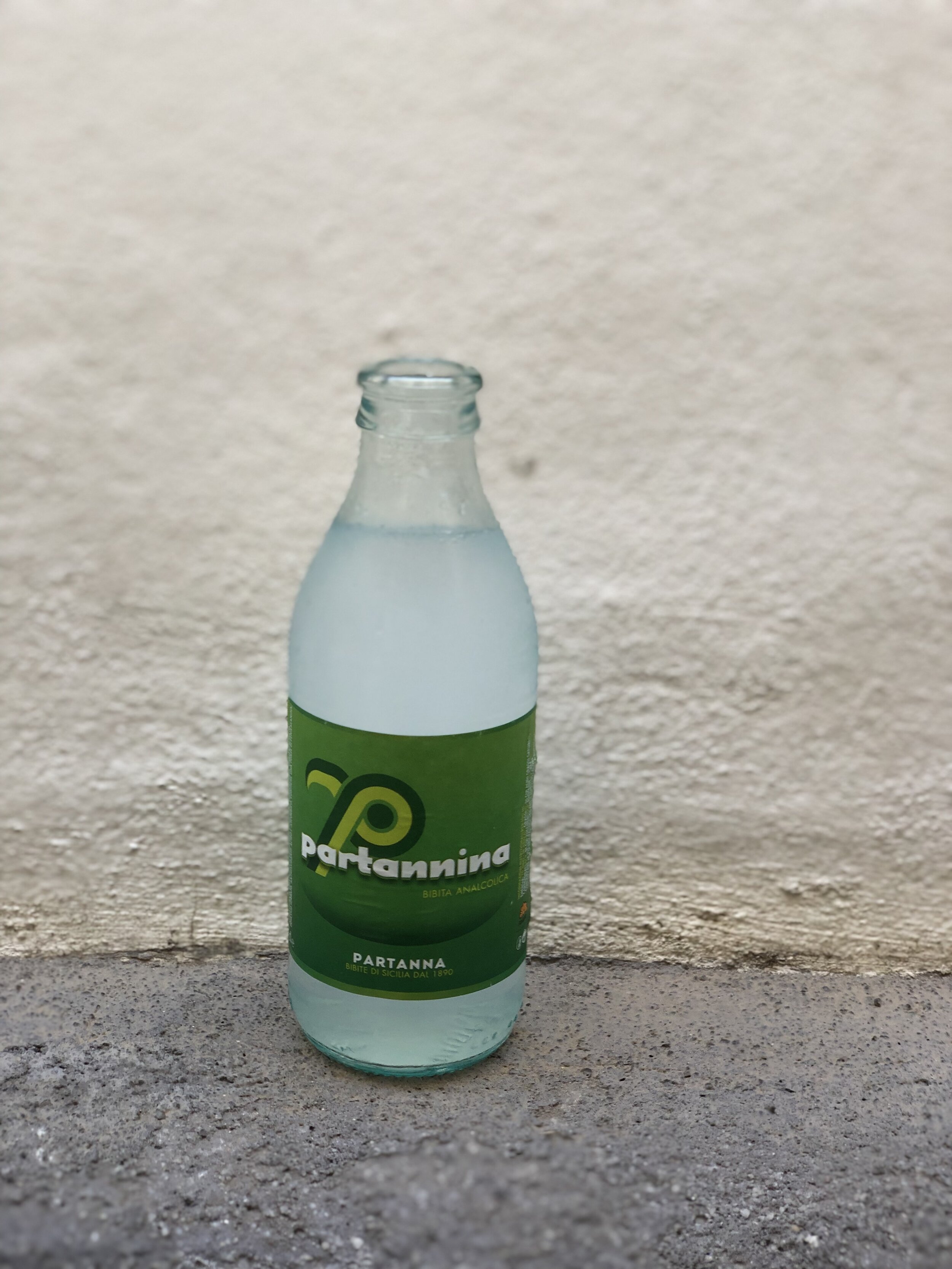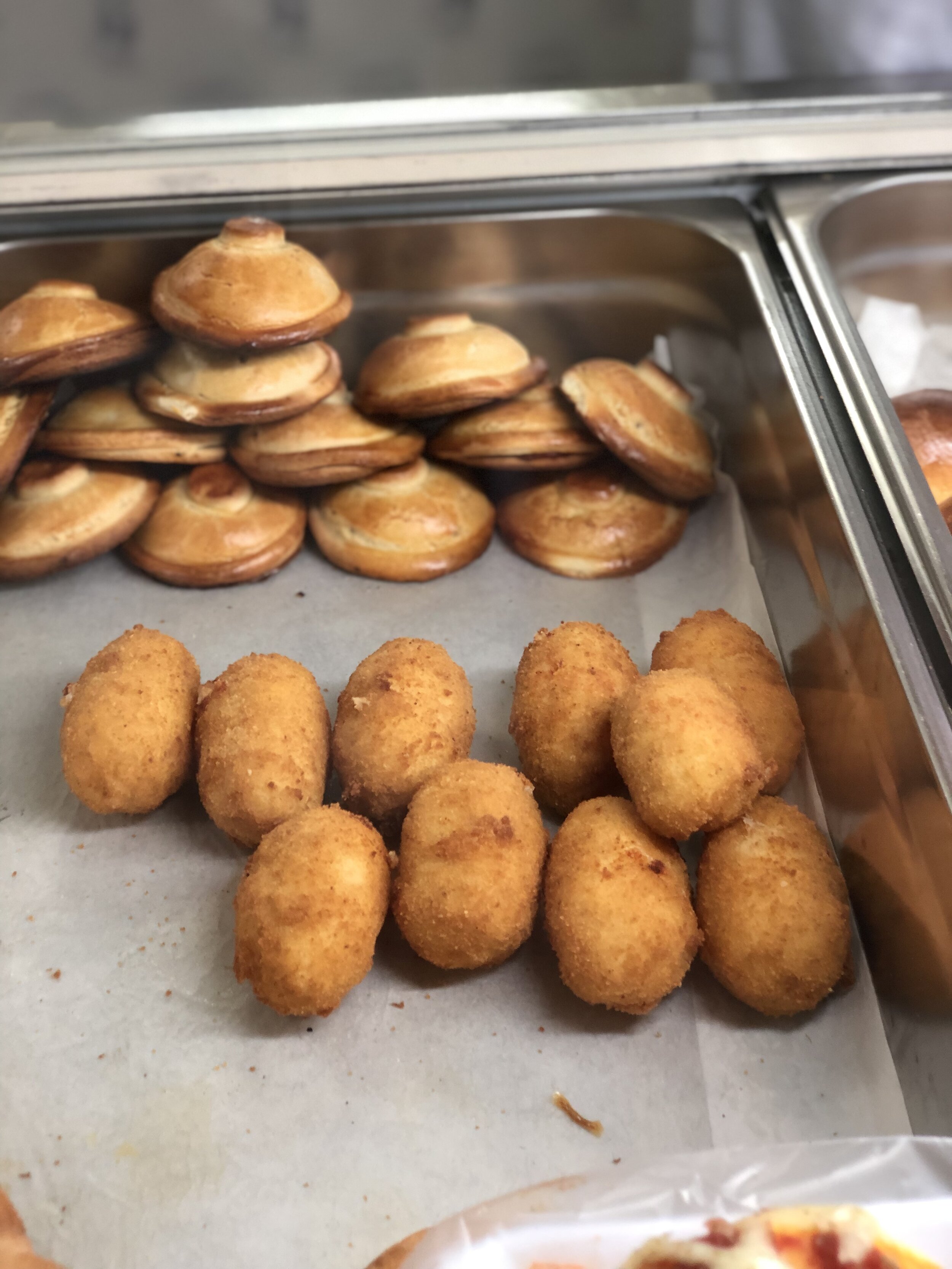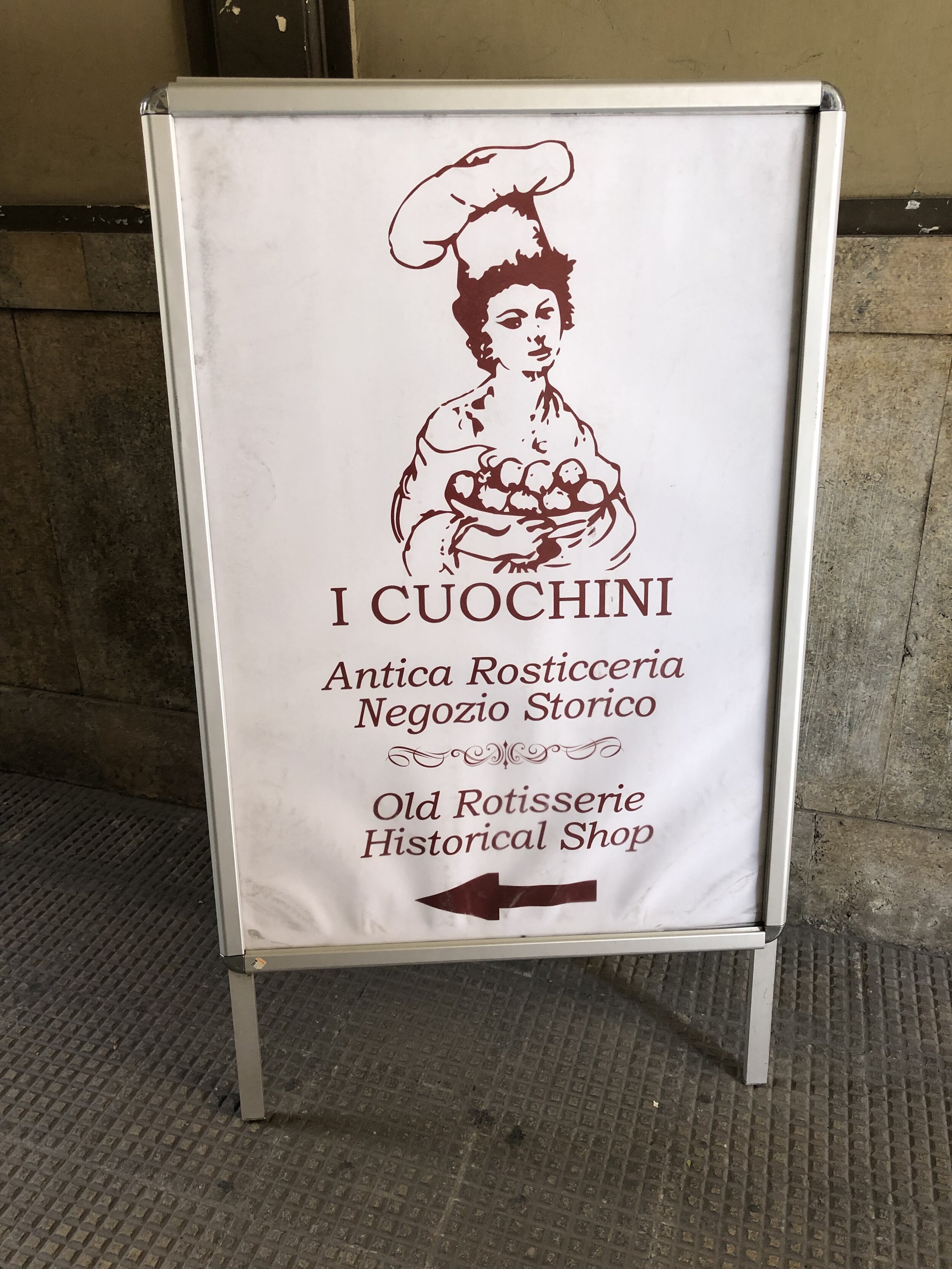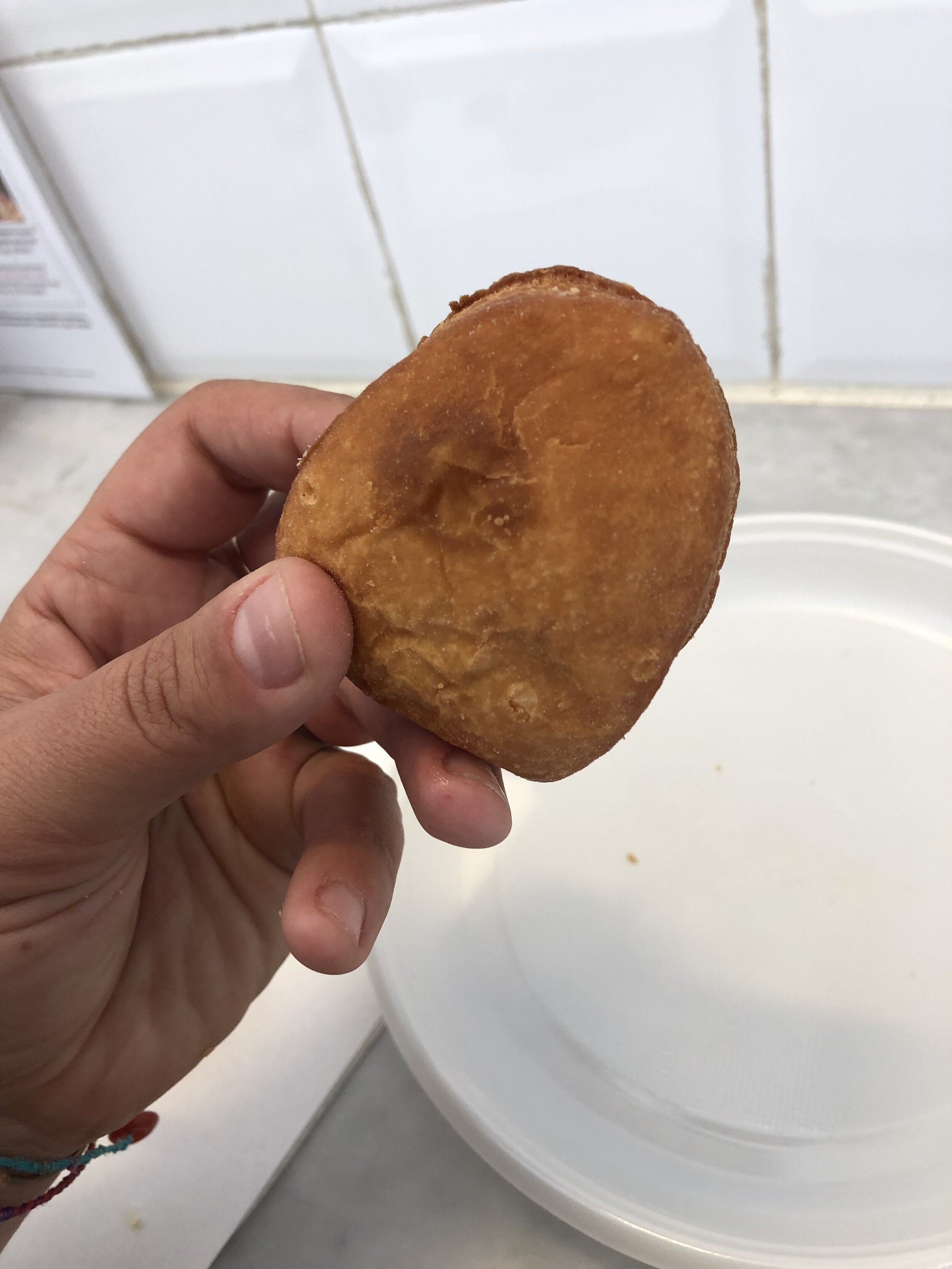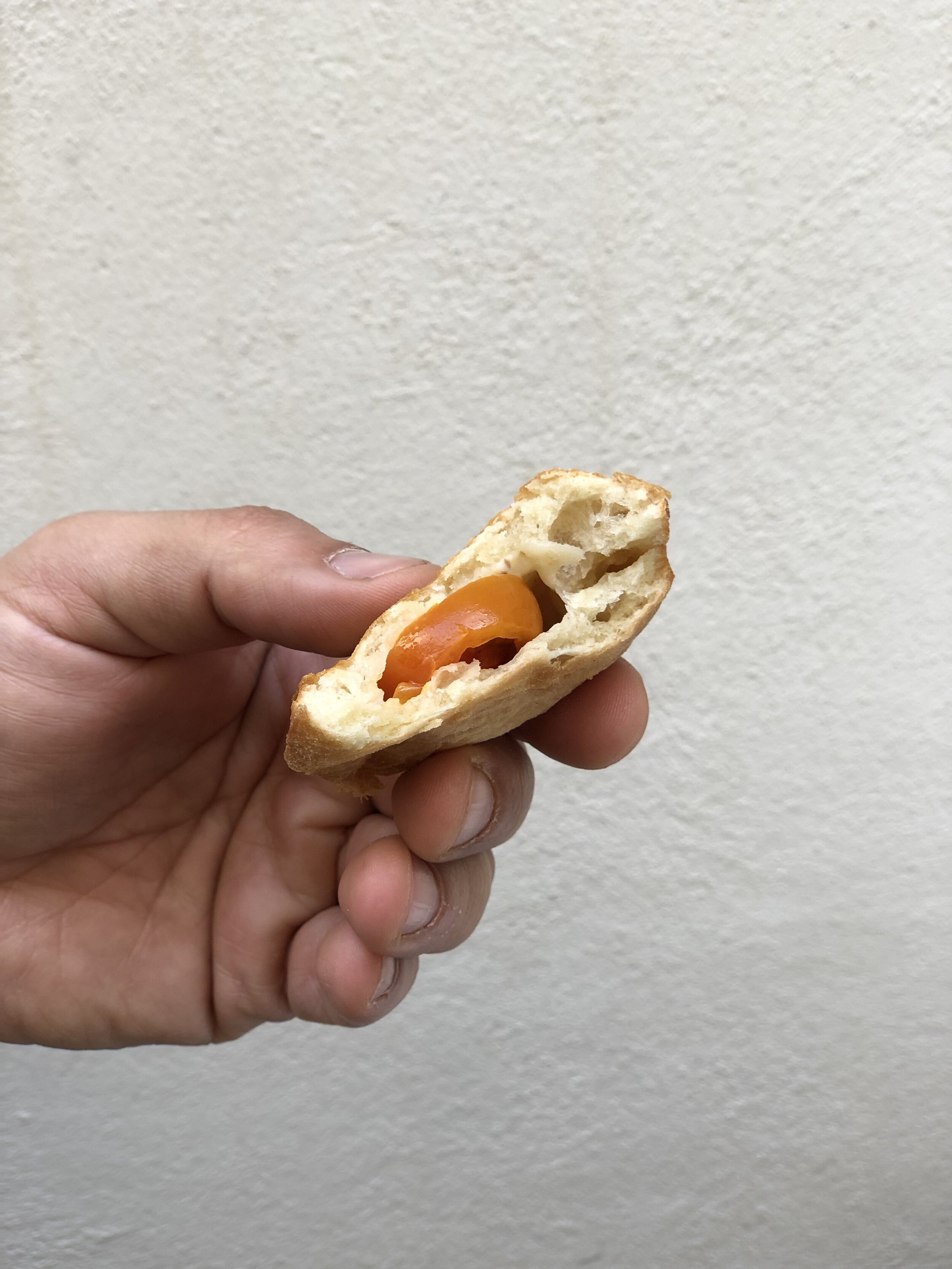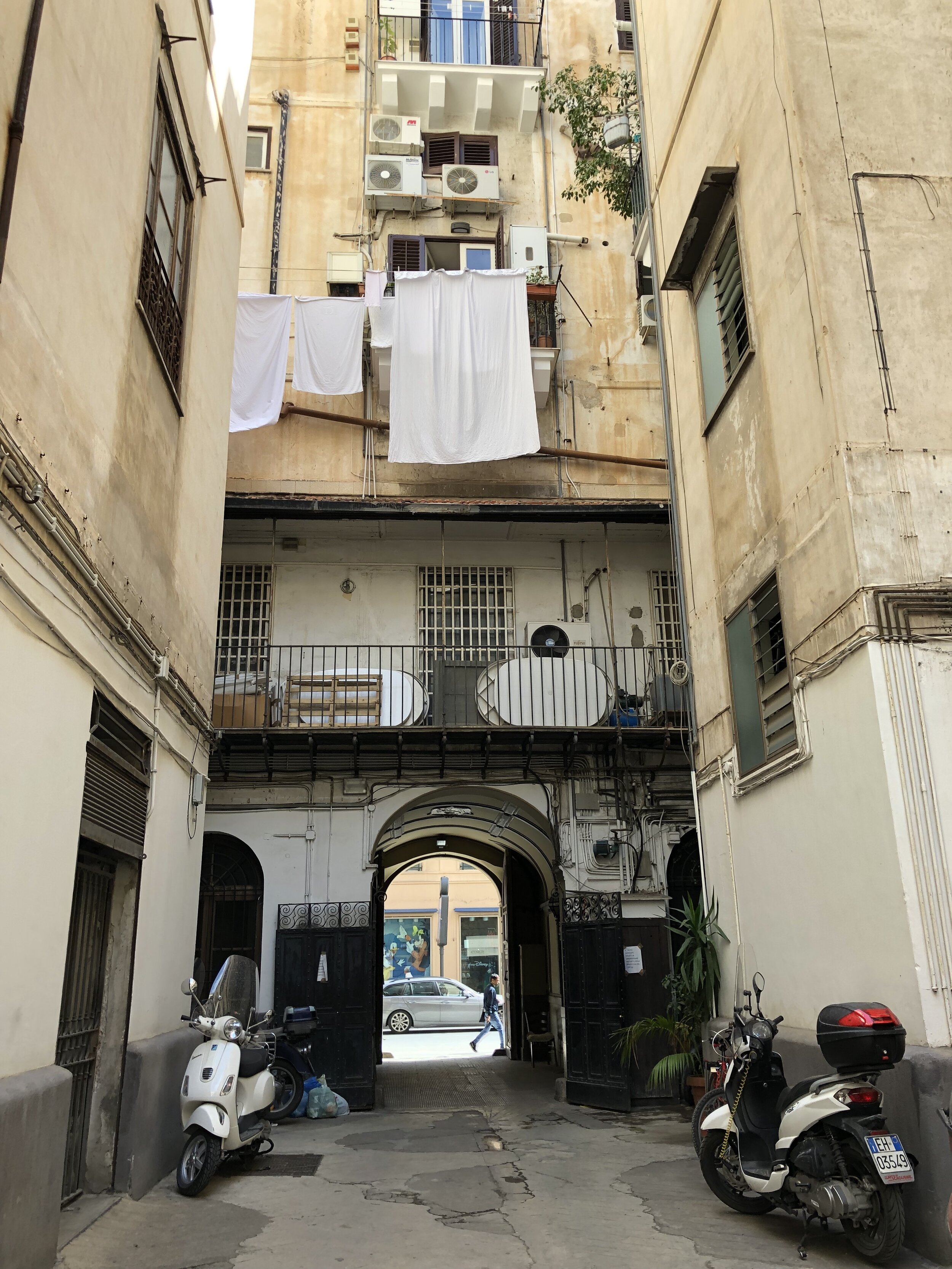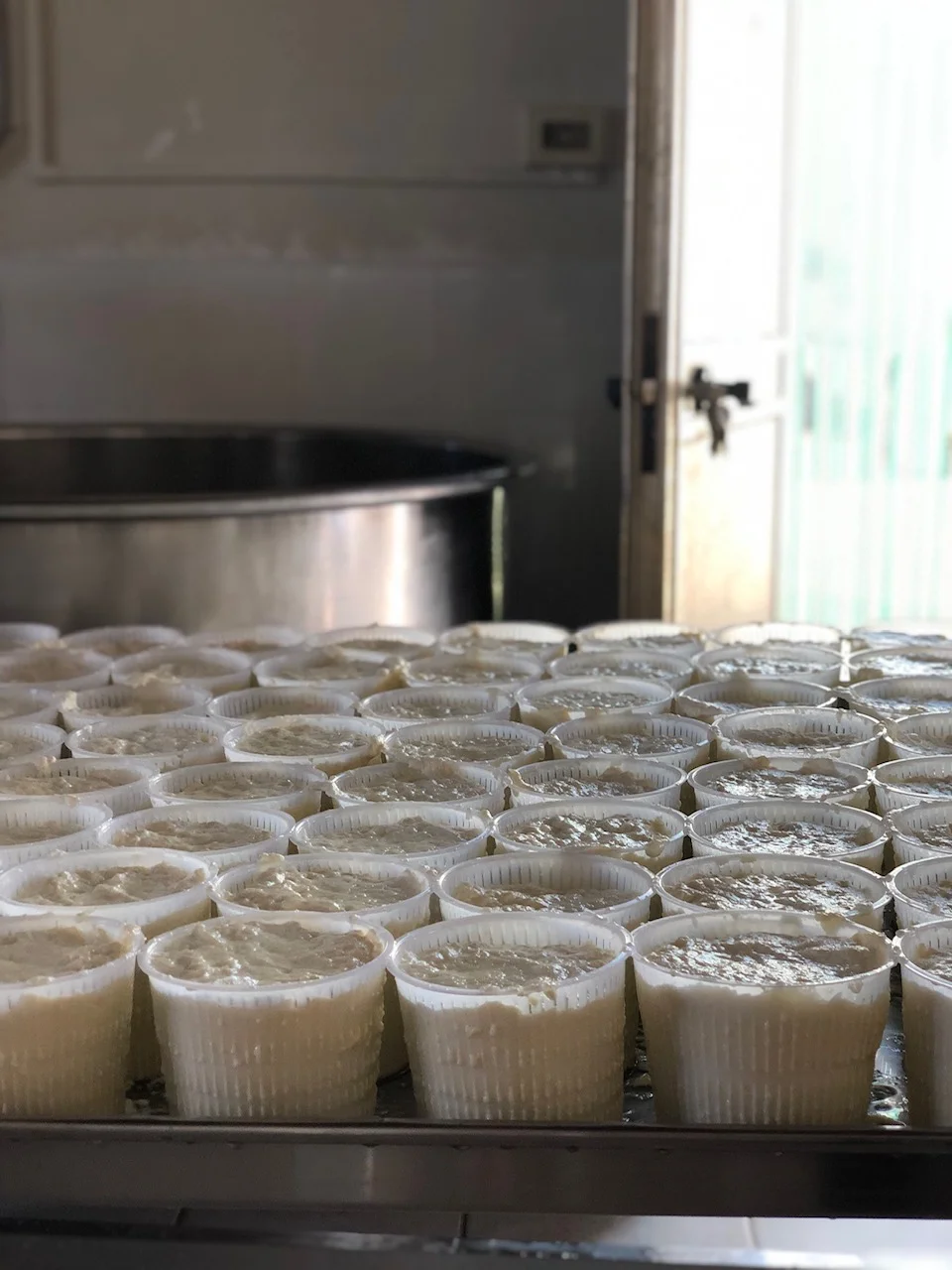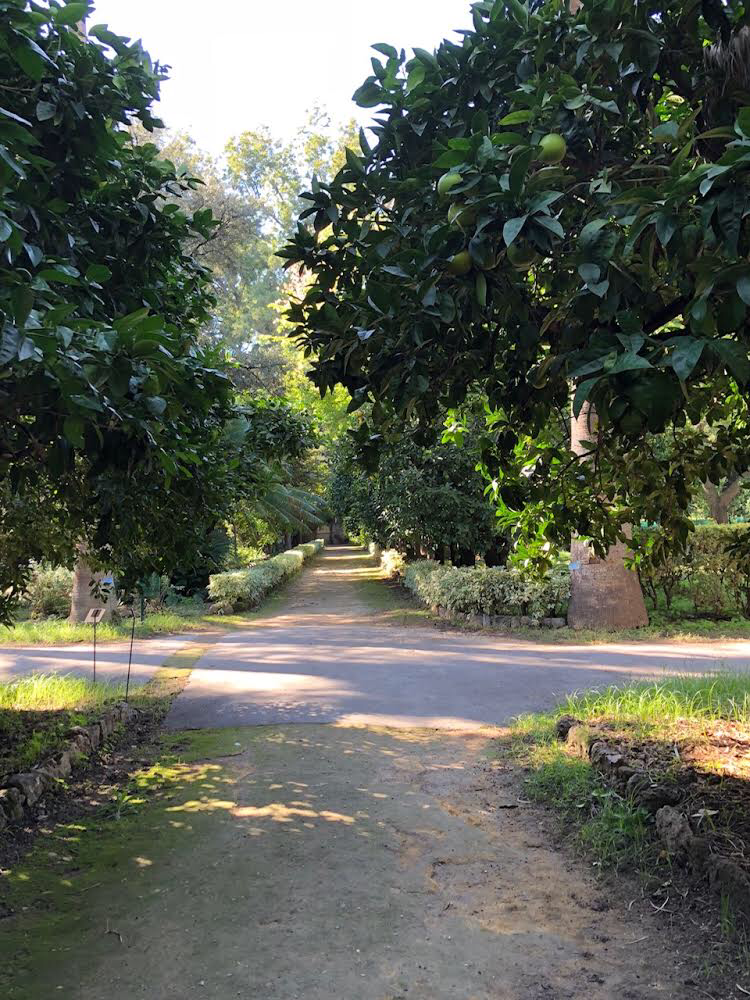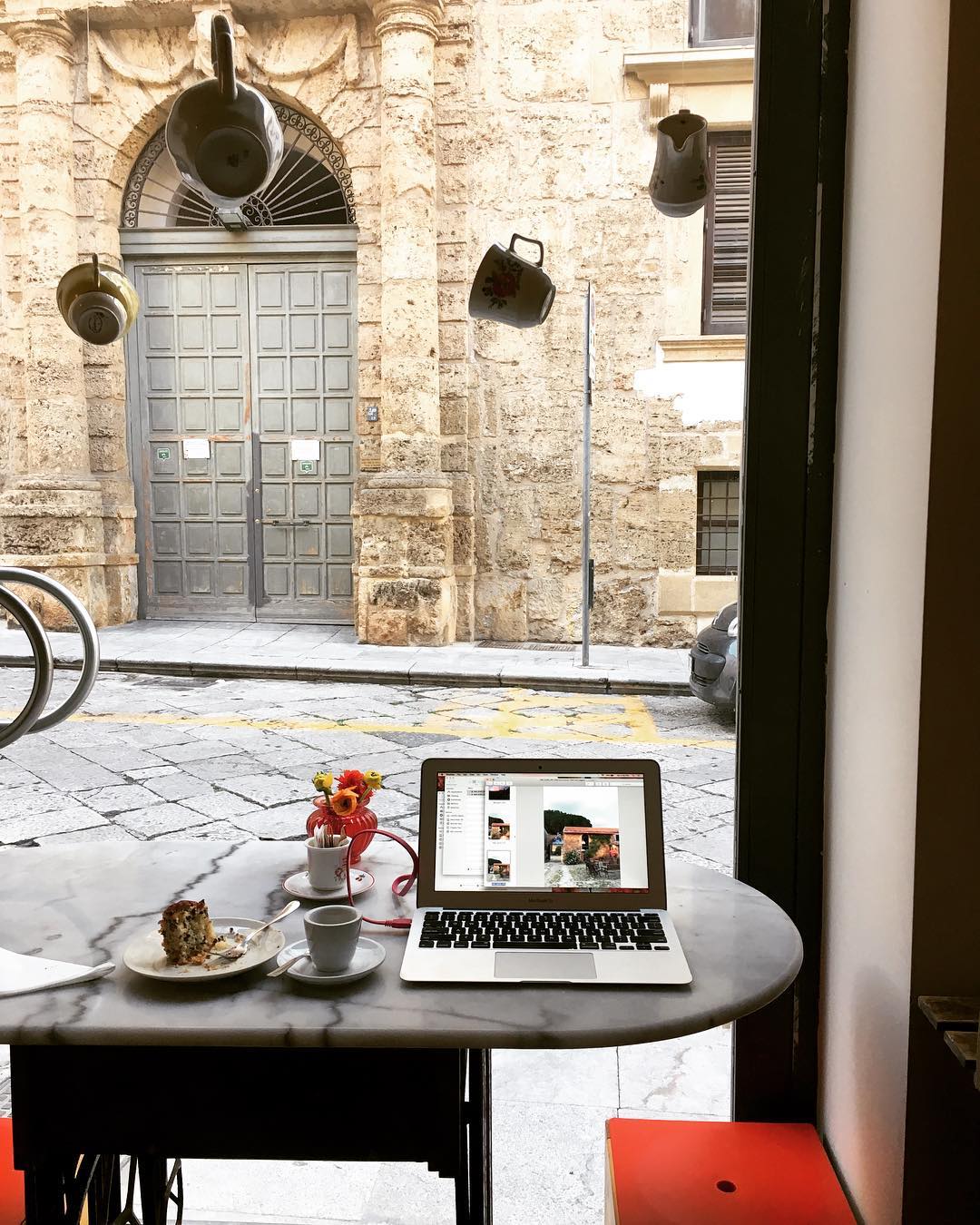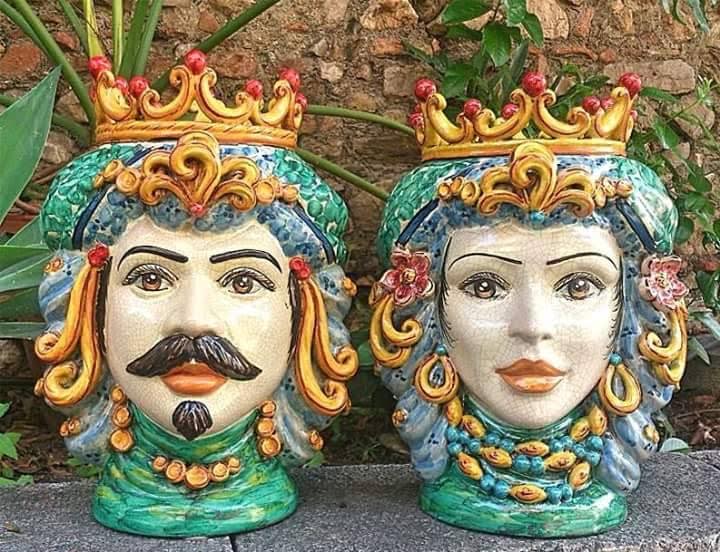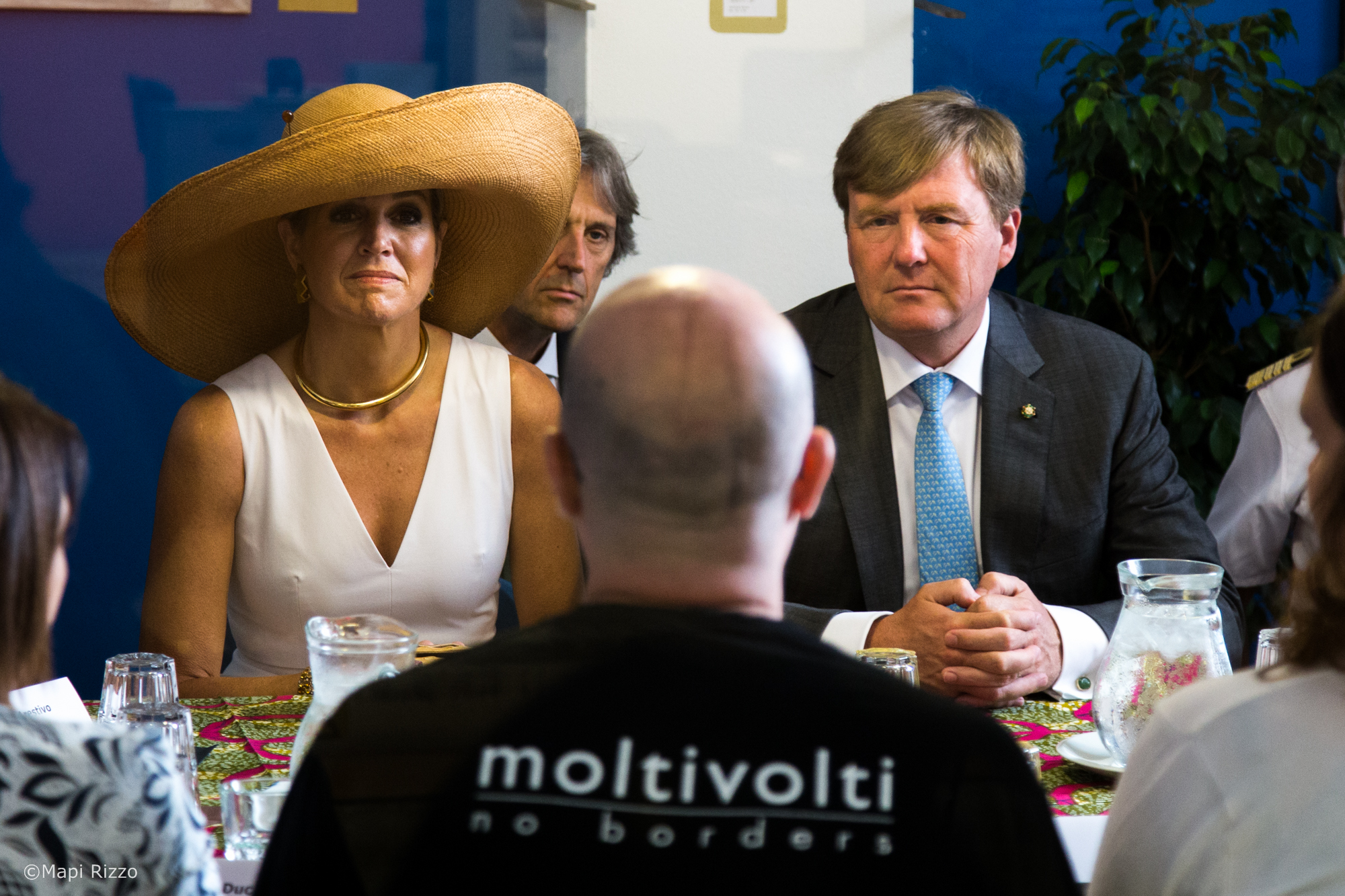We love this video! Our very own Giorgio takes the folks from Grenzenlos to some key spots in Palermo including Capo Market, Vucciria Market, and Ballarò Market.
I Cuochini: the ultimate antica rosticceria Palermitana
I Cuochini is the ultimate antica rosticceria Palermitana; tucked away, but not forgotten, for nearly 200-years! This hidden gem is located in a small courtyard just off of the bustling shopping strip in Palermo’s centro storico. Still in its original location, I Cuochini is a tiny rosticceria or savory bakery that has been serving small “pezzi” in classic Palermo-style since 1826.
A rosticceria in Sicily is a place where you can buy hot food on the spot to be quickly eaten at the banco counter or taken away. Don’t expect sit down service or even proper plates and cutlery, most of their bites or small pezzi pieces are served in a napkin or as a sampling on a plastic plate. The prices are cheap, the quality is high, and I’ve never seen a more spotless kitchen inside one of these street food kiosks in all of our snacking history.
If it’s not already, we want to put I Cuochini on your radar. It’s a simple quick stop for a savory breakfast or a snack at lunchtime since they are open 6 days per week from 8:30AM until 2:30PM. Here’s what you’ll find in the window:
“panzerotti” - small fried calzones
The best ones are zucchini flowers with cheese or the mozzarella with cherry tomato and anchovy.“timballetti” - fried bundles of angel hair pasta seasoned with meat ragu or béchamel and peas
“crocchettine di latte” - a carefully fried, savory mini milk crocchette made from bechamel with nutmeg
“pasticicini” - savory baked minced meat pies
“arancinette” - small arancine rice balls, stuffed with meat ragu and peas, or béchamel and cubes of cooked ham
“focaccine” and “brioscine” - a variety of small stuffed sandwich buns made with either pizza or brioche dough, then filled with local delicacies like chickpea fritters called “panelle”
Don’t sleep on the panzerotti or the timbaletti; they are the true treasures. Wash it all down with a cold Sicilian citrus soda called “Partannina”. Check out I Cuochini on Via Ruggero Settimo 68, just across from the Disney store and my favorite fresh flower stand.
I Cuochini, Via Ruggero Settimo 68, Palermo PA 90139
Hours:
Monday-Friday 8:30AM-2:30PM
Saturday: 8:30AM-2:30PM and 4:30PM-7:30PM
closed on Sundays
Ricotta al Forno the Recipe
Ricotta is the king of Sicilian cheeses, although it should not technically be called a cheese at all. “La ricotta non è un formaggio, ricotta è ricotta.” Ricotta is just ricotta. About 90% of ricotta made in Sicily comes from sheep’s milk, except for a small part of the island that makes it from cows milk.
The name ricotta actually signifies that it is in fact ”re-cooked” whey that is a bi-product of the first cheesemaking process in the early stages of creating pecorino. This ingredient is incredibly versatile with so many special Sicilian desserts like sfince or cassata featuring sweetened ricotta cream fillings, savory pasta dishes topped with fresh ricotta, there is the salted and aged ricotta salata, baked cinnamon ricotta cakes, or even this lesser-known slowly baked version “ricotta al forno.”
One of our favorite prepared foods to pick up in the market is “ricotta al forno.” This baked ricotta is slowly cooked in a low temperature oven for about an hour before being served on trays to the masses in the outdoor markets in Palermo. Every morning, trays are displayed in the Ballarò amongst piles of Sicilian cheeses like pecorino, ricotta salata, fresh containers of ricotta, provola, and caciocavallo.
There are several varieties of ricotta al forno depending on the toppings you add before cooking. There is a traditional version with only a drizzle of olive oil, others that are covered with Sicilian oregano, a typical Palermitan sfincione topping of tomato/breadcrumb/anchovies/onions, the fan-favorite: pistachio with orange marmellata, seasonal varieties like caramelized onions + artichokes or traditional with dry herbs and spices like rosemary, thyme, spicy red peperoncino, and black peppercorns. We like to serve ricotta al forno as an antipasto with crostini and a fresh drizzle of extra virgin olive oil or it can be used as a condiment inside of a sandwich. Here is a recipe to make ricotta al forno.
RECIPE: Ricotta al Forno (baked ricotta recipe)
Ingredients:
fresh ricotta
fresh herbs (oregano, rosemary, or thyme)
pinch of sea salt
extra virgin olive oil
The plastic strainer that the ricotta comes in helps keep a nice basket shape and allows some of the liquid to run out through the small holes. Flip the fresh ricotta out of the plastic container and let it rest in a bowl for about an hour to air dry and release some additional liquid whey. In a small bowl, prep your toppings, add a pinch of sea salt, and set aside.
Line a baking sheet with parchment paper and place the ricotta in one piece onto the tray. Cover the ricotta with a small coating of extra virgin olive oil and then press in the herb topping along the top and sides. Bake at 180°C / 350°F for 1 hour. The ricotta will harden and become a bit more compact with a beautiful overall toasted brown color. Allow it to cool slightly before cutting into it.
Palermo’s Hardcore Street Foods: Stigghiole
Palermo is famous for its street food culture. There are the crowd-pleasers like panelle chickpea fritters, fluffy sfincione, and arancine rice balls. But, only the bravest know about Palermo’s more hardcore street food. With this new series, we will introduce you to some of our favorites from the more extreme echelon.
Southern Italy, famous for “cucina povera,” a way of making due with what little you have. Now a days, these recipes are a great way to use leftover ingredients in order to create a new dish the next day or to eat well with only a few simple and affordable ingredients. With Sicily’s history of aristocratic noble families on the island, there were luscious French-inspired dishes but there are also these more common countryside dishes that were made with what was available when the best ingredients were too expensive or already given to the landowners. Eating well does not mean you have to spend a lot of money. Which leads us to the topic at hand: stigghiole.
The name stigghiole comes from the Latin word “extilia” meaning intestines, but this dish actually has Greek origins here in Sicily. Stigghiole are made with lamb, veal, or sometimes goat intestines that have been wrapped around green spring onion and a few sprigs of fresh parsley. Some versions of stigghiole wrap a small amount of meat in intestine fat first and others use no meat at all, filling them with chopped white onion, long parsley sprigs, and a sprinkle of grated pecorino cheese before coiling the outside with sausage casings. It almost looks like a sausage and really, when you think about it, it is practically the same ingredients as a sausage. The sausage casings need to be soaked in salt water and rinsed over and over again until they are cleaned properly before using. The perfect balance of fat, salt, freshness from the parsley and a little kick of raw onion make it absolutely mouthwatering.
Throughout Sicily’s “entroterra” and center of the island, you’ll easily find stigghiole in butcher shops or served in the streets during festival celebrations. They are most common in the city of Palermo where we serve them grilled over charcoal or wood-burning barbecues throughout the city center at outdoor markets like Ballarò or Vucciria. It’s a dish that most people do not make themselves since you can buy them pre-made at the butcher shop. Most commonly here in Palermo, we just eat them on the go as a street food snack with lots of lemon squeezed on top.
In Vallelunga Pratameno, a small village in central Sicily, we learned how to make stigghiole with the town butcher. In his shop, they use chopped onions, parsley, and some grated pecorino cheese. The lacy thin pieces of caul fat helped hold it together in this case because the onions were chopped into small pieces. It ends up melting away on the grill but keeps the stigghiole juicer.
In Palermo, the vendors grilling stigghiole are called “stigghiularu.” They grill stigghiole over charcoal fires then slice into bite-sized pieces finished with a squeeze of lemon juice. We absolutely love this dish and know the smell right away when we walk through the market or wander through the streets near la Vucciria after a few beers on a Friday night. The stigghiularu send up their smoke signal to make sure everyone knows where they are. With just a little piece of fat on the grill, the piazza fills with a cloud of delicious smelling smoke and it’s easy to find our beloved stigghiole. Just follow the smoke, and you’ll know what we mean.
Where to find stigghiole in Palermo:
Piazza Caracciolo also known as the old Vucciria market behind Piazza San Domenico
From Monday to Saturdays, you can find them In the Ballarò market
Fresh Pomegranate Juice
One of the best things about Palermo in fall and early winter? Fruit juice. FRESH fruit juice! Pomegranate juice is one of our favorites.
Sicily’s climate is perfect for growing luscious rich-tasting fruit. The warm days and cool nights allow pomegranate shrubs to grow much larger than the ones you might find in California, or other places in the world.
Pomegranates, native to Asia, spread through the centuries to the Middle East and then the Mediterranean. Pomegranate is called melograno in Italian. I Melograni have always been known as a symbol of fertility and bounty. Inside every pomegranate there are hundreds of edible seeds called arils. Pomegranates are rich in fiber, vitamin c, potassium, and even protein. They help reduce the risk of illness. Some even say they are an aphrodisiac!
When that winter chill comes along in Sicily pomegranates, with their high anti-inflammatory effect, are just what you need to feel good. When you press the whole fruit, pomegranate juice contains more antioxidants than any other fruit juice. All of the good stuff actually comes from the oils in the peel and the pith, so don’t forget to press the whole fruit!
In order to reap the best benefits of the pomegranate fruit, make sure to pick them when they are already ripe. This is not a fruit that will continue to ripen after it comes off of the tree. To extract the most juice, roll them on the countertop like you would do with citrus fruit.
Another easy way to pick the seeds out is to score the fruit into quarters from top to tail, then pop out each section and remove seeds from the pithy membranes. Many people also use this technique. Cut the pomegranates in half, place over a bowl, and swiftly hit the back with a wooden spoon.
Where to find Fresh Pomegranate Juice in Palermo?
During fall and early winter in Palermo, you can find pomegranates in the outdoor markets.
Many shops will sell freshly-pressed pomegranate juice for around €3 per cup.
Across from Piazza San Domenico there is a small bar that always sells freshly squeezed orange juice and when you’re lucky, you can find pomegranate juice here too.
In the Ballarò and Capo markets, there are stands that sell the juice daily. Enjoy a cup as often as you like and keep that winter cold away.
An Afternoon in Palermo’s Botanical Gardens
Eat too much fried panelle and looking for a great place in Palermo to take a long walk?You could be looking for something to do in the afternoon while shops and restaurants close for a few hours. Do yourself a favor and spend an afternoon visiting Palermo’s exceptional Botanical Gardens.
This enormous outdoor museum has been around for nearly 200 years, dating back to the late 18th century. Because of Palermo's favorable climate, many unknown and poorly classified exotic tropical plants were able to thrive here. As a result, Palermo became an important point of reference for other large botanical gardens around Northern Europe. And today, Palermo’s Botanical Garden contains at least 12,000 different species of plants!
When you first arrive to the botanical garden in Palermo, you’ll see a central neo-classical building, known as the Gymnasium. Two smaller buildings are located either side are the Calidarium and the Tepidarium. Originally these smaller buildings housed plants from warm “caldo” and temperate “tiepido” zones.
The oldest section of the gardens is the rectangular Linneian. It is divided into four quarters that is then split into flower beds. The Aquarium is a large round pool surrounded by the lagoon and other small ponds that hosts a variety of aquatic flora.
The Winter Garden is a series of 1,300 square-meters of greenhouses gifted by Queen Maria Carolina of Austria. Originally, it was constructed of wood and heated by stoves, but eventually it was completely rebuilt in cast-iron. Other greenhouses are filled with succulents, coffee plants, cinnamon, bougainvillea and mimosa, bananas, papaya trees, ferns, and other plants from hot-arid climates like Africa, Central America, South America, Asia and Australia.
The Herbarium Mediterraneum was founded at the beginning of the 19th century and hosts a collection of plants, ferns, mosses, funghi and lichens that come from Sicily. It contains a diverse selection of preserved and dried fruit and seeds dating back to the early 20th century. During the summer season, the garden staff collects plants and seeds throughout Sicily that will be identified and stored in the botanical garden’s Seed Bank.
A new addition to the Botanical Gardens is Radiceterna Arte e Ambiente, a non-profit cultural association dedicated to the production, support, and development of contemporary art. Through exhibitions, publications, lectures and live performances, they have created a platform to encourage the public to engage with contemporary art in an environmentally sustainable way.
How to visit the Botanical Gardens in Palermo?
Here’s the info for the Radiceterna Project:
www.radiceterna.org | May–November: 9AM-1PM, 2PM-6PM | Calidarium Pavillion
Here’s the info for the Palermo Botanical Garden:
Orto Botanico dell'Università degli Studi di Palermo
Via Lincoln 2, Palermo 90133, Sicilia, Italia | +39 91 23891236 | ortobotanico@unipa.it
Hours:Open every day except December 25 and January 1st.
March: 9AM-6PM
April: 9AM-7PM
May - August: 9AM-8PM
September: 9AM-7PM
October: 9AM-6PM
November - February: 9AM-5PM
Entrance Fees:
€5 general entry
€3 for students, children ages 6-17, adults over 65
€10 Family Ticket includes two adults, two children
Free entrance for children under 5, disabled guests and their companions, and University of Palermo students.
Cucuzza Longa - Those Crazy Zucchine
Il serpente di Sicilia, aka the Sicilian snake, aka cucuzza longa. This is the Sicilian vegetable that catches most people's eyes the first time they visit a market in Palermo.
This vegetable might look absurd or even comical, but we can assure you, it is much less crazy than it seems!
This vegetable is simply a variety of zucchina.
The origins of this zucchina are not totally known. What we know for sure is that it is a vegetable typical of Southern Italy and Northern Africa.
The name zucchina serpente is linked to its snake-like form. In fact, it is shocking! These zucchine are so long, they can sometimes grow to be the length of adult people.
This vegetable is also know as cucuzza longa. Cucuzza is Sicilian dialect for zucchina, and longa means, well, long!
Cucuzza ni voo'?
The cucuzza longa is tender and spongy. It must be eaten while it is young, otherwise it becomes too hard to eat. It is very low in calories and it is principally made up of water, something like 90%.
This zucchina is the fruit of an invasive plant that produces very tender leaves and small buds that are used to make a typical Sicilian pasta dish: pasta con i tenerumi.
In the Palermitan diet, the zucchina itself is often steamed with tomato, potatoes, and onions and served in a room-temperature summer soup, with extra virgin olive oil and bread crostini.
Top 10 Street Food Blogs & Websites For Street Food Lovers in 2018
The Palermo Street Food Blog has been named one of the top Street Food Blogs in the world in 2018 by FeedSpot.
We are on the list with blogs from around the world! From Bangkok, to NYC, to Delhi. We are a global street food community.
The street food blogs on this list are chosen from thousands of Street Food Blogs. Blogs are chosen based on: Reputation on Google, Social Media Influence, Post consistency, Feedspot’s opinion.
Auguri to the Palermo Street Food Team and all the Street Food Producers in Palermo!
The Guides at Palermo Street Food know Exactly the Place to Take You
Ehh! Check us out in European Travel Magazine!
"It’s the Palermitano version of Fish & Chips, and in poor times a cheap source of proteins and carbohydrates, thanks to the chickpea flour. These golden nuggets can be bought anywhere in Palermo, but the guys at Palermo Street Food will show you the best place to taste them. It’s only 2€ for a paper cone with 5 panelle and 5 crocchè and will qualify for lunch.
"Very rich and highly addictive, you may have tasted these confections (cannoli) before – but you’ve never had them better than in Sicily! You can buy them everywhere, but the guides at Palermo Street Food know exactly the place to take you. This is where the locals go themselves, and that’s always a seal of approval for you!"
Read the full article, here.
Street food is King in Palermo
From our friend Kelly McGlinchey after her Palermo Street Food Tour.
"Breakfast this morning - a "triplo" sandwich with fried chickpea, potato and eggplant for only 1.50 Euro. Street food is king in Palermo, ranked number 5 in the world for this cuisine category. The five rules of Palermo street food, as told by @palermostreetfood, are as follows: 1. It must use local ingredients. 2. It must have historical significance. 3. It must be cheap. 4. It must be soft (a nod to when the poor of Palermo lacked teeth) and 5. It must use five ingredients or less. "
You can get more travel inspiration for Palermo by checking out momondo’s Palermo Guide.
From Brooklyn to Palermo, a Chat with The Cheeky Chef
We first met Linda circa Festa di Santa Rosalia 2013 and we've been eating and drinking amazing things with her ever since. After a long stint back in Brooklyn, NY, Cheeky is back in La Conca d'Oro!
We just sat down and chatted with Linda about being back in Palermo.
Palermo Street Food (PSF): So, Linda Linduccia, you just moved back to Palermo from Brooklyn, something you have been planning for a long time now. You have traveled to so many places in the world, what keeps you coming back to Palermo?
Linda Sarris (LS): Palermo is the best city. Ever. Next question ... Just, kidding, I'll answer. Settling here was an obvious choice for me. Palermo has always been a place where I could escape. Days here are filled with adventures in the food markets, late night street food, meeting friends, really cheap drinks. I love being here and soaking up the energy of this place. I feel here in Palermo the same way foreigners feel an electric energy when they visit New York.
PSF: Ok, so what was the first thing you ate the other day when you arrived in Palermo?
LS: Every time I arrive in Palermo I go straight to the Mercato del Capo food market behind Teatro Massimo. I visit the same fishmonger and buy a small box of fish meatballs from him. They are made with swordfish, parsley, and currants. I could live off of those things. Perfectly fried polpette with the combination of sweet and savory that you find in a lot of dishes here. The fishmonger definitely remembers me, but we are not exactly friends yet. I'm working on it. I told him the story that this is my first stop every time I come back to Palermo and he loved it!
PSF: As a chef I am sure your cooking must change here in Palermo. Which ingredient are you currently obsessed with cooking?
LS: I am a chef who has always focused on fresh seafood and coastal flavors so you can imagine how crazy I go here with the fish selection. When it comes to cooking in Sicily, I always go for the things that I cannot find at home. Tenerumi, or squash runner greens, long zucchini the size of baseball bats, little red mullet fish called triglie, and wild fennel whenever I can find it.
PSF: Where is your go to place for grocery shopping in Palermo?
LS: I found an apartment in Centro Storico because I do not have a car and I like when I can just walk everywhere I want to go, like in New York where hardly anyone has cars. One of my favorite things about being here is having your special "pushers" that you can become a regular customer with. I am scouring the food markets now since I'm new in town to make sure I pick the right fishmonger and the vegetable stand guys. In a supermarket or bakery it is not such a big deal, but in a public market the loyalty is very important here. As a Chef visiting Palermo, the outdoor food markets are a dream come true. I actually like visiting them all and since they are so close together, it's not crazy to buy fish in Capo and vegetables in Ballarò. There are a few men in Vucciria that I visit only to buy salted sardines, homemade bottarga, or fresh tuna.
PSF: I remember when you took the Palermo Street Food tour a few years ago, we spent a lot of that night hanging out and drinking lots of grillo in Vucciria. Do you still hang out in Vucciria at night?
LS: I actually don't like going into Vucciria that much anymore. The small square is a market in the morning and the piazza turns into a great place to hang out at night drinking beers outside and sampling street food. Maybe I am getting old, but I think the crowd has changed over the last 3 years and there are much younger "ragazzi" hanging out and it's a bit too crowded for me. Maybe weeknights are better but on the weekend it is madness. There are still the same guys, since forever, making food in La Vucciria, which I love. The boiled octopus, grilled sausages and stigghiole, mangia e bevi (scallions wrapped in pancetta) and the fried panelle is always a good idea.
PSF: Where do you like to go now to just have a drink and chill?
LS: There is a nice bar on Via Maqueda near the Quattro Canti called Bistrot Bisso. It's really central and perfect for lunch or an aperitivo. I always loved Bar Garibaldi and there is another place Colletti that makes good cocktails. For a coffee and cake, I like Cioccolateria Lorenzo in Piazza Marina. Cana Enoteca is a nice place to hideaway with a glass of wine on Via Alloro.
Cioccolateria Lorenzo,
one of The Cheeky Chef's favorite working cafe spots in Palermo.
PSF: You have lived in both the countryside and city in Sicily. The first time we met you was at Case Vecchie! You were in full campagnola mode, apprenticing with your mentor Fabrizia Lanza. Do you miss it sometimes? Sicilian countryside farmer life?
LS: Yes of course! I actually go quite often. I have been in Palermo for about a month and have already spent time in Sambuca di Sicilia, Regaleali where the Tasca d'Almerita family has their winery and cooking school, and also Camporeale. With my life as a freelancer, I have flexibility to write and work from anywhere. That was part of the main plan for my move here. I am cooking less for work but enjoying it more when I can actually cook for friends. I am writing a small guide book on my own for tourists coming to Sicily, I am developing a travel program for an agency in Rome, and helping out with a few other food/wine projects with friends here. It's important to get a nice mix of city and countryside. Sicily has it all and even in January it's beautiful to sit by the seaside.
PSF: Where is your favorite place to go from Palermo for a day trip by train?
LS: Train travel here is tricky. I prefer to rent a car which is actually VERY cheap. I mean this month, since it is winter, I have found car rentals for between 6-10 euros per day.
PSF: Where do you like to go if you just go for a Sunday drive from Palermo?
LS: I love Mondello the beach town outside of Palermo and you can get there on the public bus. For a longer trip, Scopello is great in the summer or San Vito lo Capo and the Riserva dello Zingaro are top! Also the ferry to the island of Ustica is a wonderful day trip in summer from Palermo. You can go there and back just for the day.
PSF: You are in the process on perfecting your Italian and Sicilian!
LS: I love the challenge of spending time in a place that forces me to speak another language. It's amazing how fast you start to pick it up when you have no other choice.
PSF: What's the Sicilian word you use most often?
LS: Amunì! Which means, Andiamo. Which means, let's get a move on people!
PSF: What's new that's badass? Can you share one of your upcoming Sicily projects you are working on?
LS: Yes! Two things. First, I am working on a top-secret bread baking workshop with the Anna Tasca Lanza Cooking School. We are inviting bakers from all over the world to come for a collaborative week this fall to experiment with local flours.
PSF: Hot. Second?
LS: I am leading a week-long trip this May with the Di Giovanna Organic Winery in Sambuca di Sicilia where we will bring guests on adventures through the western side of the island. We want to give tourists a real "Life in Sicily" experience by organizing winery visits, cooking lessons, trips to see how ricotta is made and visit the sea salt pans near Marsala.
PSF: But what about the street food in Palermo!?!?
LS: Tranquillo!! That will be the next trip.
PSF: Final thoughts?
LS: Yes, check this out, I'm learning to slow down my walking because I'm so obviously a New Yorker sometimes. Sicilians take their time. Everything is on a slower pace.
PS: Meglio così!
LS: In fatti!
Known best as The Cheeky Chef, Linda Sarris splits her time between cooking for female CEOs in New York City and working as a food/travel consultant based in Palermo, Italy. She's the founder of the project SNACK Sicily. You can visit her website, here. You can also follow her on Instagram, here.
Palermo Christmas
Best Wishes from Christmas in Palermo.
<3
Freshly Pressed Extra Virgin Olive Oil in Sicily
It's the most wonderful time of the year.
Green Sicilian gold. This is the best place to hang out in early November in Sicily, at the olive mill.
The Sicilian Human Head Planter Trend
Sicily is an island full of history, traditions, and legends.
During its long lasting life, Sicily has had so many different dominations. These dominations have influneced everything in Sicily from our food, to our culture, to our language.
In this article we are going to tell you about one of the most enchating symbols of the Sicilian ceramic art tradition: La Testa di Moro.
There are two legends about this topic and both involve two lovers, a Moro (Moro means Arabian man) and a Sicilian woman.
The first legend tells us about a love affair between an aristocratic beautiful Sicilian woman and a beautiful Arabian man. They had a clandestine love for many years.
Then one day, the woman's family found out their secret. The family felt a huge shame for their love. The woman's family decided that the only way to save their family honor was to kill both and expose their heads on their balcony. After they did so and some time passed, the heads started to deteriorate. The family then had 2 ceramic vases custom made depicting the tragic couple's faces, so that their heads could be on display forever.
Here's the second legend. This legend says that around the 1000 ac, when the island was dominated by the Arabians, a young beautiful Arabian man developed a crush on a young beautiful Sicilian woman who lived in one of the buildings in "Al Hàlisah," a neighborhood known today in Palermo as La Kalsa (where we go on our Palermo Street Food tours!)
The man tried so hard to make eye contact with his crush; he was hoping to have a chance to speak with her. Finally the woman noticed him too and the man had his opportunity to declare his true love for her. The woman immediately fell in love with his intensity and passion.
Shortly after, the man confessed to her the truth about this life, that he was actually already married and he had to go back to his family (smh). The woman felt so sad about the idea of losing her love forever. She also felt betraid and that her pride had been dishonored.
So, she decided to kill the man and cut his head off. She put his head on her balcony with all her other plant vases. She planted a basil plant (from Basilikos, the king plant) inside the head and she watered the plant for the rest of her life with her tears.
Since then the head-planter trend took off. Sicilians still think that planters shaped like heads are a very nice way to decorate their balconies.
Both legends have some similarities and explain why also today we see these planters. We do not know which is the true legend, but we do know that these stories were very important and have survived after almost 1000 years.
Today you can find the Testa di Moro symbol all around Sicily. But the most important village for the creation of these pieces of art is Caltagirone, a city famous for their great ceramic tradition. The main steps in the village of Caltagirone are decorated with ceramic that reproduce the story of our different dominations. Every 14 steps the style changes according to the different dominations: Phoenicians, Greeks, Romans, Normans etc.
The Urban Planning of Palermo
Do you know the shape of Palermo? Today it is kind of like a scraggly half moon that hugs the coast of the Tyrrhenian Sea. But That is not how it has always been.
It all started in the 700 AD when the Phoenicians decided to build a small settlement in the area we now know as Palermo. They chose this area probably because they wanted to take advantage of the surrounding mountains which provided a natural system of defense.
Fast forward to the the Kalbids, an Arab Muslim people that ruled Sicily from 948ish to 1053ish and used Balàrmuh (aka Palermo) as an important economic hub in the Mediterranean. Actually, legend has it that it was the Kalbid people who brought LEMONS to Sicily! Ok, sorry, we digress... gahh, not everything has to ALWAYS be about food... just, most of the time!
Anyway, back to Palermo's urban history. The Kalbids had the city set up as a rectangle. The main street in this rectangle went from the port to the palace. This street was called Il Cassaro, which is today's Corso Vittorio Emanuele; although, most locals know what you mean if you say "Il Cassaro," even today.
Il Cassaro meets Via Maqueda where, in the 1600s, the famous Quatro Canti were constructed. This is one of the most famous cross roads in the world. Actually, Palermo's historic city center is the largest city center in Europe. And that is precisely where we suggest that most people stay when they visit our city. Our favorite site for finding an apartment to stay in, in Palermo, is on the website of our friends at Likibu because they compare all of the popular apartment rental sites (here's the link).
Oh, and, here's another fun fact, Il Parco della Favorita, is the largest urban park in Italy. You can even see it on this map above. Don't you love it? It was designed for us by our friends at Modern Art Map. They have a mission to create art using imagery, colors, and maps to capture the essence of a city. Of course for Palermo they choose a passionate red! Here's the link to their site.
Dolce & Gabbana in Palermo
We are totally enamored with Domenico Dolce and Stefano Gabbana right now.
You know that dishonest thing brands do? When they represent a place or a culture but they do it wrong or so inappropriately it is offensive? THIS IS NOT THAT. This is amazing and we want to thank Domenico and Stefano for giving Palermo, Monreale, and SIcily in general the honor they deserve.
Did you know that Domenico Dolce is from Polizzi Generosa in the province of Palermo? In the late 1970s, Dolce and Gabbana, the most famous fashion duo started in Palermo before moving to Milano.
Stefano Gabbana on the left and Domenico Dolce on the right
And in fact, for the past 5 days, Palermo and Monreale have been the international showroom of their new collection. And in the past days, both Domenico and Stefano expressed their extreme admiration for Palermo and the hilltop city of Monreale.
In the past few days, they have created so many beautiful things celebrating our city. They created a pop-up boutique and pop-up Martini Vermouth bar inside Tonnara Florio which is in Palermo's tiny neighborhood Arenella.
They also inaugurated a new cocktail called Ciuri Ciuri, paying homage to the iconic Sicilian folk song. This is the recipe for the Ciuri Ciuri cocktail:
1 part Martini White Vermouth
1 part vodka
1 hint of Spuma Bionda di Sicilia
1 organg slice
Hanging out in Tonnaro Florio drinking the Ciuri Ciuri cocktail.
Other events include, a fashion show in Piazza Pretoria, known colloquially to Palermitan locals as La Piazza della Vergogna. They actually put on a full high fashion show around the piazza's fountain. Another event was a re-enactment of the ballroom scene from Il Gattopardo (The film the Leopard) in Piazza Croce dei Vespri. Also there were other pop-up showrooms in Palazzo Gangi.
Fashion show in Piazza Pretoria
Domenico and Stefano are in love with the Arab/Norman period and if you take a look at their latest fashion collection, you can see these periods represent in their clothing.
The Netherlands Royalty are Charmed by Palermo and its way to Welcome Immigrants
King Willem Alexander and Queen Máxima came to visit Palermo on June 21, 2017. They were pleasantly surprised by Palermo's multicultural and diverse environment. They expressed their support for the city of Palermo in its efforts, helping immigrants and refugees who have escaped unlivable situations in other countries. The King and Queen visited Palazzo delle Aquile, I Quatro Canti, La Cattedrale, and the Palazzo dei Normanni.
The Queen and King of Holland with Mayor Leoluca Orlando of Palermo.
During their visit, they didn't miss Capo Market and obviously they ate some of our city's street food! In particular, they went crazy for le polpettine di pesce spada (small swordfish "meat" balls).
The King of Holland eating some street food in Capo Market in Palermo.
The Queen and King also found a moment during their visit to stop by Moltivolti, a co-working space in Ballarò. The were totally interested in their project and spent time with Claudio Arestivo, the co-founder of Moltivolti, talking to him about the challenges of his project.
Sicily: Recipes from an Italian Island
Go get this book.
It's called Sicily: Recipes from an Italian Island by Katie and Giancarlo Caldesi and it is gorgeous.
Katie and Giancarlo are from the UK and we had the extreme pleasure of hanging out with them while they were researching their book.
They are amazing people. What a privilege to have helped them with their book.
This is our acknowledgement in the book. Not gonna lie, we are pretty proud to be the first listed as "Things to do in Palermo."
This is Chef Marco Piraino. MARCO sei troppo bello in questo foto!! We introduced Katie and Giancarlo to Marco. He's an amazing chef. Just look at that arancina!
Where to buy the book? If you are in NYC go pick up your copy at Archestratus in Brooklyn; it's a destination for anyone who loves Sicily. Just go there. You will thank us. If you are in London, go get yourself a copy at Books for Cooks.
When We Ate Octopus Head
You can tell by Salvatore's black lips that we are not joking around. We ate this octopus head and it was AHMMMazing. Just another friday night in Palermo!
Presenting: the Palermo Street Food Sicilian Wine Tasting!
We know what you're thinking, it's about time!! Yes! Ladies and Gents, The Palermo Street Food Sicilian Wine Tasting!
It's no secret that the wine drinking portion of our Palermo Street Food Tours is one of the best parts of the tour. So, now, we bring you a full activity in Palermo dedicated 100% to wine. Evviva!
We are working with our lovely sommelier friend, and member of the Palermo Street Food team, Francesca. She is heading up all the tasting. Francesca is a great somm, crazy about Perricone, and a Palermo native. She knows everything there is to know about Sicilian wines!
You can read more about our Sicilian Wine Tastings held in Palermo, Sicily here. And if you have any questions, just email our wine team vino@palermostreetfood.com.
Cheers!
